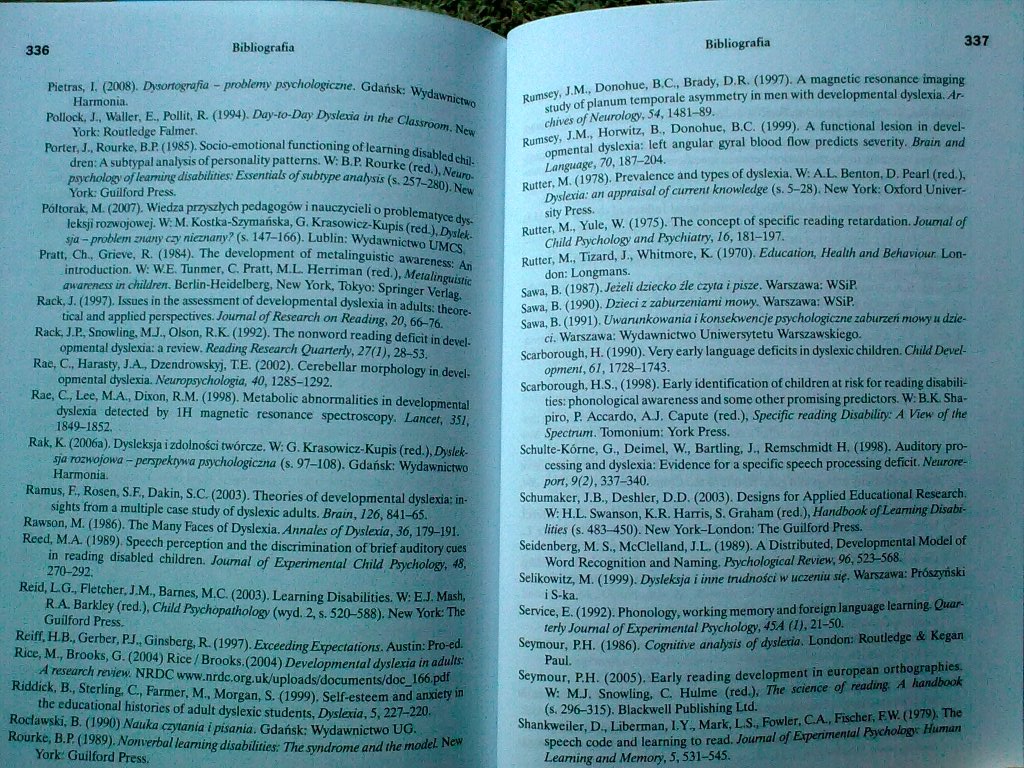Zdjęcie4040

336 Bibliografia
Pietras, f. (2006). Dysortografia - problemy psychologiczne. Gdańsk: Wydawnictwo Harmonia.
PbOock. J.. Wolier. £. Pollit, R. (I9W). Day-to-Day Dysicaa in the Classwom. New York: Routledge Ftlmcr.
Porter, J., Rourke. B.P. (1905). Socio-emotional functioning of Icaming disabled chd-dren: A subtypal anahsrs of personolity pattems. W: B.P. Rourke (red), Neuro-psychologyof leaming disabilities: Essenrialsofsubtype anatysis(s. 257-280). New York: Gtfdfórd Press.
Półtorak. M. (2007). Wiedza przyszłych pedagogów i nauczycieli o problematyce dys* Icfcsji rozwojowej. W: M. Kostka-Szymańska, G. Krasowicz-Kupis (n<L). Dyskusja - problem znany czy nieznany? (s. 147-166). Lublin: Wydawnictwo UMCS, Pratt. Ol, Grieve, R. (1984). The development of metal mguistic awareness: Ań iniroduction. W: WE. Ton mer. G Pratt, MJ_ Herriman (red.), Metalinguistk awareness in cłuUrau Berlin-Heidclbcrg. New York. Ihkyo: Springer Ycrlag, Rack. J. (1997). Issues in the assessment of developmental dysleria in adults: theorc-tical and appłicd pcrspecthrs. Journal of Research on Reading, 20,66-76.
Rade, J.P., Snowłing, M J., Obon, R.K. (1992). The nonword rcading defirit in dcyel-opmcntal dysleria: a revicw. Reading Research Quarteriy, 27(1), 28-53.
Rae, G, Harasty, JA, Dzendrowskyj, T.E. (2002). Cerebellar morphology in devd-opmeotal dysleria. Neumpsychologia, 40,1285-1292.
Rac, G, Lee, MA, Doon, R M. (1998). Metabolic abnormalities in dewlopmental dysleria detected by 1H magnetic rcsonance spectroscopy, Lanco, 351, 1849-1852.
Rak, K. (2006a). Dysleksja i zdolności twórcze. W: G. Krasowicz-Kupis (rcó.)t D)slek-sja rozwojowa - perspektywa psychologiczna (s. 97-108). Gdańsk; Wydawnictwo Harmonia.
Ramus, F,, Roscn, S.F., Dakin, S,G(2003). Theoriesof developmental dysleria; in-Mghts froro a raultiple casc study of dysleric adults. Brain. 126,841-65.
Rawson, M. (1986). The Many Ricesof Dysleria. Annalesof Dyslexia,36,179-191. Reed, MA (1989). Speech pcrcepńon and the discrimination ofbrief auditory cues in reading disabled children. Journal of Experimental CJiild Psychology, 48, 270-292.
Reid, LG-, Fletcher, J-M>, Barnes. M.G (2003). Leaming Disabilities. W: EJ. Mash, RA Barkley (red.), Child Psychopatholo& (wyd.2, s. 520-588). New York; The Gutlford Press.
Reiff. H.B., Gerber, PJ., Ginsberg, R. (1997). ExceedingExpectations. Austin: Pnx&
R*ce, M., Brooks, G. (2004) Ricc / Brooks.(2004) Developmenlal dyslexia In adults:
A nsearch renety. NROC wwwjirdc.org.uk/uploads/documenls/doc_166.pdf Riddick, B., Srerling, C., Farmer, M., Morgan, S. (1999), Self-csteem and anriety in the cducational histones of aduJt dysleric studenta, Dyslada, 5,227-220. Rodawski. B. (1990) Nauka czytania i pisania. Gdańsk: Wydawnictwo UC.. | Rourke, B.P. (1989). Nonwrbal leaming disabilities: Thesyndrome and the model New
_nnlłforfł Pr**<__
Rumsey, J.M., Donohuc, B.C. Brady, D.R. (1997). A magnetic rcsonancc imaging study of planum tcmporale asymmetry in men with devclopmental dyslcxia.Ar-chrvesofNeurology,54,1481-89.
Rumsey, J.M., Hoiwitz, B.. Donohuc, B.C. (1999). A functional lesion in devel-opmental dyslcxia: left angular gyral błood flow predicts scverity. Brom and Language, 70,187-204.
Rutter. M. (1978). Prcvalencc and typcs of dyslexia. W: AL. Benton, D. Pcurl (red.), Dyslaia: an appmisat of currenl knowtedge (s. 5-28). New York: (Mord Unłvcr-sity Press.
Rutter, M.t Yulc, W. (1975). The conccpt of specific reading reiardalkm. Journal of Chlld Psychology and Psychiatry, 16,181-197.
Rutter, Mi, Tizard, J., Whitmore, K, (1970). Education, Health and Behaviour. London: Longmans.
Sawa, B. (1987).7«Wi dziecko źle czyta i pisze. Warszawa: WSiP.
Sawa, B. (1990). Dzieci z zaburzeniami mony. Warszawa: WSiP.
Sawa, B. (1991). Uwarunkowania i konsekwencje psychologiczne zaburzeń mony u dzieci. Warszawa: Wydawnictwo Uniwersytetu Warszawskiego.
Scarborough, H. (1990). Very eariy language deficits in dyslexic children. ChildDend-opment, 61,1728-1743.
Scarborough, H.S., (1998). Eariy Identification of children at rak for reading disabih-ties: phonological awareness and some other promising prcdictors. W: B.K. Sba-piro, P. Accardo, AJ. Caputę (red.), Specific reading DisabiUty: A View of the Spectrum. Ibmonium: York Press.
Schulte-Kóme, G., Deimel, W., Banling, J., Remschmidt H. (1998). Audiloiy Processing and dysleria: Evidencę for a specific speech processing deficit. Neurore-port, 9(2), 337-340.
Schumaker, J.B., Deshler, D.D. (2003). Dcsigns for Applied Educational Research. W: H.L. Swanson, K.R. Harris, S. Graham (red.), Handbook of Leaming Disabilities (s. 483-450). New York-Londoo: The Guflford Press.
Seidcnberg, M. S., McClelland, J.L. (1989). A Distributed, Devełopmcnial Model of Word Recognition and Naming. Psychological Bevtew, 96,523-568.
Selikowitz, M. (1999). Dysleksja i inne trudności w uczeniu sif. Wfcrnawa: Prószyński iS-ka.
Senóce, E. (1992). PhonoJogy, working memoiy and foreign language learnlng. Quar-terfy Journal of Ezperimental Psychology, 45A (l), 21-50.
Seymour, P.H. (1986). Cogmtne anałysis of dysicaa. London: Routłedge A Kegan Paul.
Seymour, P.H. (2005). Eariy reading development in european oribographies. W: M J. Snowling, C Hulme (red,). The science of reading, A handbook (s. 296-315). Blackwcll Publishing Ud.
Shankwciler, D.. Uberman. LY, Mark; US, Fowler. CA, Fischer, EW. (1979). The speech codę and leaming to read. Journal of Ejpenmetual Psychology: Humań Leaming and Memory, 5,531-545.__ * ■ _
Wyszukiwarka
Podobne podstrony:
zdjecie46�2 PROBLEMY PSYCHOLOGICZNE PACJENTOM/ CHORYru REUMATOIDALNE ZAPALENIE STAWÓW
zdjecie46�2 PROBLEMY PSYCHOLOGICZNE PACJENTOM/ CHORYru REUMATOIDALNE ZAPALENIE STAWÓW
Zdjęcie4042 340 Bibliografia Sprenger-CharoHo*. L, Cole, R, .Semiclaw, W. (2006). Reading acr/utslrt
Zdj?cie0273 Ujęcie tradycyjne vs ujęcie współczesne • RywafcuKp(psycho«wftm
img071 PROBLEMATYKA PSYCHOLOGII ROZWOJOWEJ Zmiany, jakim podlega psychika człowieka przez całe życie
18259 S5001379 (3) 7 Zajęcia ruchowedla dzieci z problemami psychologicznymi Rozdział ten opisuje za
img071 PROBLEMATYKA PSYCHOLOGII ROZWOJOWEJ Zmiany, jakim podlega psychika człowieka przez całe życie
CZĘŚĆ PIERWSZAWprowadzenie do problematyki psychologii zeznań Rozdział IHistoryczne tradycje
Częsc pierwsza. Wprowadzenie do problematyki psychologii zeznan Carl von Eckartshausen znany jest pr
Częsc pierwsza. Wprowadzenie do problematyki psychologii zeznan psychologia sądowa rozpłynęła się ja
Częsc pierwsza. Wprowadzenie do problematyki psychologii zeznan (czynnik „p”). Przewaga czynnika
Częsc pierwsza. Wprowadzenie do problematyki psychologii zeznan podstawowym kierunkiem eksperckiej p
głównie na problemy psychologii stosowanej (klinicznych, ergonomicznych) stwarza dogodne warunki do
ppglądy/ Zdarzenia Z posiedzenia Komisji Historii Książki i Bibliotek listopada 2006 roku odbyło się
więcej podobnych podstron